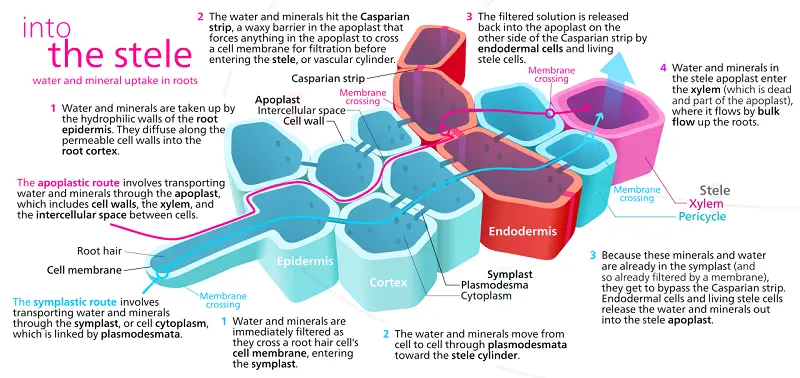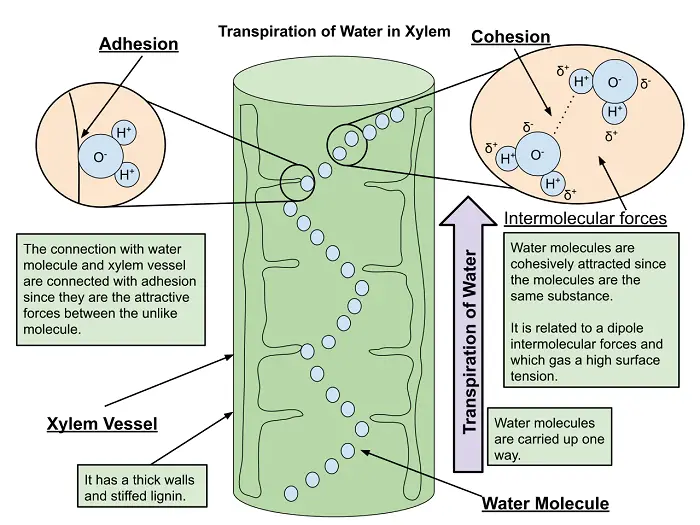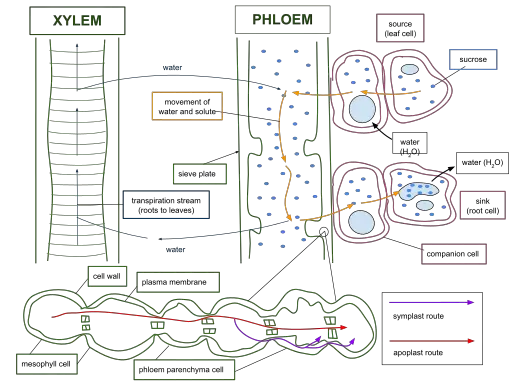Plant Nutrition and Transport
Aristotle thought the soil provided all the substances for plant growth. In the 17th century, Jan Baptista van Helmont performed an experiment and concluded that water mainly contributed to plant growth. A century later, Stephen Hales postulated that plants are nourished mostly by air.
As it turns out, all these early hypotheses about plant nutrition contribute to plant growth. A plant’s leaves exchange gases and detect sunlight to facilitate photosynthesis and cellular respiration, while the roots extract nutrients and water from the soil.
Talking about the roots, we have mentioned the presence of root hairs. All substances that enter the root are in solution (dissolved in water) and having root hairs provide an extensive area that is in contact with the nutrient-containing soil. For water and solutes to enter the root, they must move through the epidermis and cortex before going into the water-conducting xylem tissue in the root’s vascular cylinder.
Any route the water and solutes take must pass through some plasma membranes of root cells and because of selective permeability, only certain solutes reach the xylem. The plasma membrane thus acts like a checkpoint that transports needed minerals from the soil and keeps unwanted or toxic substances out.

Two possible routes can also be taken by substances entering the root: the intracellular route and the extracellular route. The former allows substances to pass through the cell interiors through the plasmodesmata while the latter allows passage through cell walls and spaces between cells.
However, a continuous waxy barrier, the Casparian strip, stops water and solutes from entering the xylem through cell walls and forces them to cross the plasma membrane into an endodermal cell. Water and solutes rarely follow the two kinds of routes but because of the Casparian strip, they must at some point cross a selectively permeable plasma membrane.
Transpiration and Water Transport
Plants require a constant supply of water and dissolved minerals from the soil. This is provided as xylem sap, a solution of water and inorganic nutrients that flows from the roots through the shoot system to the leaves. Xylem sap flows through very thin tubes within xylem tissue and is pulled by transpiration, the loss of water from leaves by evaporation.
Because of the properties of water (cohesion and adhesion, hence the mechanism is also called cohesion-adhesion mechanism of transpiration), no energy is expended by the plant. Think of it as if you are sucking a drink with a straw. As you sip, you pull the contents of the straw towards you and in turn, the liquid. So as the plants lose water vapor, there comes a force (tension) that pulls the water and its dissolved contents from the roots to the shoot. This force is also known as transpiration pull.

Because a plant requires excessive amounts of water for photosynthesis, adaptations that increase photosynthesis have a chance of increasing water loss by transpiration. The leaf stomata, which can open and close, are important in keeping the water content in plants in check. As mentioned previously, guard cells control the opening of a stoma by changing its shape–swelling apart to open a gap between the two cells, or deflating to close the stomata.
The stoma opens when guard cells gain potassium ions (K+) by active transport and thereafter water from nearby cells follows. As vacuoles in the guard cells gain water, the cells become more turgid and bowed, leading the guard cell to buckle outward and open the stoma. When the guard cell loses the K+ ions, they also lose water by osmosis and become flaccid, closing the space between them.
Sugar Transport
Whereas the xylem transports water and dissolved minerals, the main function of the phloem is to transport the products of photosynthesis from the organs where they are stored to wherever they are needed.
In angiosperms, the sieve tube elements contain perforations in their sieve plates that connect the cytosol of the living cells into one continuous solution. The sugary liquid called the phloem sap can freely flow from one cell to the next. Phloem sap may contain inorganic ions, amino acids, and plant hormones in transit from one part of the plant to the other, but its main solute is usually the disaccharide sucrose.

In contrast to xylem sap, which flows upward from roots to leaves, phloem sap moves in various directions with the sieve tubes always carrying sugar from a source to a sink. The sugar source produces the sugar, by photosynthesis or by breaking down starch. Leaves are the primary sugar source for most mature plants.
A sugar sink is an organ that consumes or stores sugar. Growing roots, buds, stems, and fruits are sugar sinks. A storage organ, such as a tuber or bulb, may either be a source or sink depending on the season.
The flow of phloem sap can be explained by the pressure-flow mechanism. At the sugar source, sugar is loaded into phloem by active transport. This raises the solute concentration inside the phloem and because of the increased solute concentration, water is drawn into the phloem by osmosis. The flow of water usually comes from the xylem, and when it enters the phloem, it raises the water pressure at the source end of the phloem tube.
This pressure pushes the sugar towards the end of the phloem with lower solute concentrations. At the sink, the sugar departs the phloem and lowers the solute concentration. Water follows by osmosis and water pressure decreases. The water then re-enters the xylem. Sieve plates allow free movement of solutes as well as water. Thus, sugar is carried along from a source to the sink at the same rate as the water.
We have taken into consideration how water and sugars are transported in plants. In the next article, we will look at the nutrients plants acquire from the soil and you might see some similarities or differences with animal nutrition.
Next topic: Plant Nutrients and the Soil
Previous topic: Reproduction in Flowering Plants
Return to the main article: Plant Form and Functions
Download Article in PDF Format
Test Yourself!
1. Practice Questions [PDF Download]
2. Answer Key [PDF Download]
Copyright Notice
All materials contained on this site are protected by the Republic of the Philippines copyright law and may not be reproduced, distributed, transmitted, displayed, published, or broadcast without the prior written permission of filipiknow.net or in the case of third party materials, the owner of that content. You may not alter or remove any trademark, copyright, or other notice from copies of the content. Be warned that we have already reported and helped terminate several websites and YouTube channels for blatantly stealing our content. If you wish to use filipiknow.net content for commercial purposes, such as for content syndication, etc., please contact us at legal(at)filipiknow(dot)net